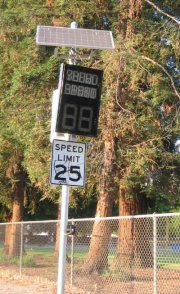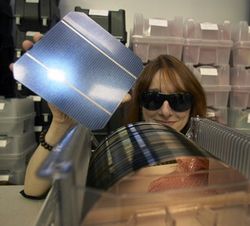Very slowly the U.S. electrical grid is breaking up, and that move will accelerate over the next few years.
How far it goes depends on the utilities, and whether policymakers are willing to force them into the right choices.
You can see the break-up proceeding on an afternoon drive. What started with phones is now extending to speed measurement sensors installed in school zones, and (as I understand) in other areas as well. Waymarketing shows off a large collection of such devices — tsunami warning sirens, weather stations, ticket dispensers and pay boxes, even trash cans (with compactors).
These can quickly be installed where the grid does not go, and the traffic signs don't go out when the grid goes down.
Watches and other battery-powered devices are likewise going off the grid, in this case the battery replacement grid. Small solar cells on the face of such products provide enough power to run most such devices. I recall having a solar-powered calculator back in the 1990s, so their proliferation is as much a function as reducing the energy drain of the device as increasing the capability of the cell. Expect cell phones to go next.
But the real breakthroughs are yet to come, and are being driven by companies like IBM.
In the last few years IBM has been developing several innovations it now says are ready for the market:
- IBM is getting ready to roll out CIGS thin film solar technology. It says the technology, which uses copper, indium, gallium, and selenide, can be printed and deliver electricity at $1 per kilowatt — directly competitive with chip-based solar panels.
- IBM has developed a way to recycle old silicon wafers for use in solar installations. This solves two problems at once, the waste generated by chip plants and a growing shortage of raw materials by solar cell makers.
- IBM has created magnifying lenses that increase the capabilities of the average solar cell five-fold. This emerged from technology originally developed to cool chips as lines on them got closer together earlier this decade.
It's the first breakthrough that holds the big promise. CIGS lets you embed solar cell technology into asphalt, into sidewalks, and (more important perhaps) into the siding and windows of ordinary homes.
How much electricity could the average homeowner collect using such a system, and how much would the installation cost? This has yet to be determined, and IBM is playing a cagey game here, proposing to license the technology to manufacturers so it doesn't take the risks of actually selling the stuff, servicing it and (worse) dealing with angry customers when the next generation comes out and delivers more power at ever-less cost. (Moore's Law may indeed apply here, at least for a time.)
What this can mean, within two years, is that most warehouses (big roofs, low power use) may be disconnected from the electrical grid. In five years, many homes in wealthy neighborhoods will be generating more power than they need to run electrical appliances.
This is where it gets interesting. If the grid is able to both buy and sell electricity, people can reduce their need for expensive batteries and fuel cell systems. Instead of building new sub-stations, electrical utilities could be building hydrolyzers and fuel cell systems, which could collect excess power when it's available and deliver back-up power when the rest of the grid goes down, rendering it much more robust, less vulnerable to disruption.
Or not. I could easily see larger businesses and commercial real estate developers developing their own storage and back-up systems, just as many companies today run their own Internet-linked networks because the monopolists want too much for the bits. Once those investments are made, the incentive for building the two-way grid goes down, and poorer customers are stuck, unable to buy what they need to be self-sufficient.
My point today is that the Internet holds models for how this can go, both positive and negative lessons. It's imperative on utilities that they learn to adjust to this new buy-and-sell model, and imperative that policymakers push them toward this. Otherwise a lot of excess power is going to be lost (power we could easily convert for use in transport), our systems become inefficient, and class differences become ever-sharper.
What could easily happen in 2020 if we don't act wisely in this case is that, when a blackout hits, the poor neighborhoods will go dark while the rich neighborhoods stay lit. And what comes out of that darkness you don't want to know.












“What could easily happen in 2020 if we don’t act wisely in this case is that, when a blackout hits, the poor neighborhoods will go dark while the rich neighborhoods stay lit.”
This happens in many places already, as poor neighborhoods often get less maintenance.
“What could easily happen in 2020 if we don’t act wisely in this case is that, when a blackout hits, the poor neighborhoods will go dark while the rich neighborhoods stay lit.”
This happens in many places already, as poor neighborhoods often get less maintenance.
Hi Dana,
you have a typo – it is $1 per watt not kilowatt a mistake of three orders of magnitude.
cheers Paul
Hi Dana,
you have a typo – it is $1 per watt not kilowatt a mistake of three orders of magnitude.
cheers Paul